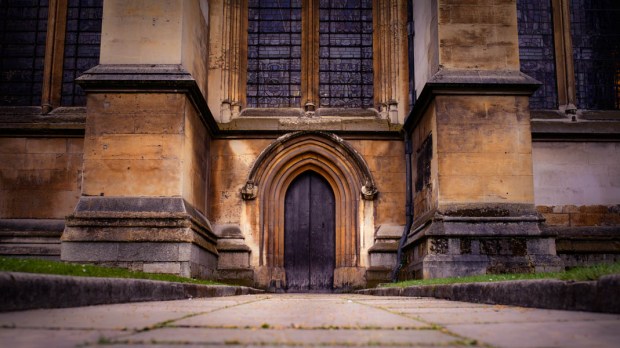In the storied halls of Westminster Abbey, nestled inconspicuously in the corner, stands an unassuming oaken door. Its dark brown panels are held together by old-fashioned iron straps on the ends, and in place of a handle there is a sliding latch. Walking through, you may never even take note of its relevance. At least, not until it was labeled with a sign identifying it as the oldest door in Britain.
In order to determine the age of the door, researchers from the Oxford Dendrochronology Laboratory bored a tiny hole in the wood so they could examine the tree-rings of the grain. Each year of a tree’s life is marked by another ring on the wood and each ring’s thickness is determined by the weather. From these rings they determined the door was crafted in the 1050s, at about the same time the original abbey was constructed by King Edward the Confessor.
Their findings also cleared up a long-standing legend regarding minute remains of skin, discovered behind the iron straps. Many theories have been suggested as to how the bits of tissue came to be stuck to the door. A popular legend links the skin to a famous robbery that took place in Westminster Abbey in 1303.
At that time, the Pyx Chamber was used by the king as a treasury, and when it was robbed the abbey’s monks were suspected, since they had the most access to the room. The abbot and 48 monks were taken to the Tower of London and eventually two of them were convicted of the theft. It was long believed that the skin on the door once belonged to the man who was punished for the robbery by being flayed and having his skin nailed to the door.
This theory was disproved by scientific testing, which identified the skin as cow hide, which could have been painted over in order to decorate the door. The presence of skin fragments on both sides of the door suggest that the door had at one time stood in a place of prominence and both sides were similarly decorated.
Researchers know that the door is not hanging on its original hinges, because the top has clearly been cut to fit its current doorway. Today, it stands about 6 feet tall, but they believe it once measured upwards of 9 feet.
In a thorough report on the door, Reverend Dr. Nicholas Sagovsky, Canon Theologian, notes that roughly 200 years after its construction, Westminster Abbey was rebuilt by Henry III, in honor of Edward the Confessor’s having been recognized as a saint. During this time, just about every aspect of the abbey was rebuilt and no expense was spared. Through all this, however, the door remained.
Sagovsky suggests that the door may have had a special link to the saint. It could have been the door to the room in which they laid his body, or perhaps a room where Edward said his daily prayers. These, however, are theories, with very little evidence connecting the door to the old king.
Today the door is recognized as a piece with significant historical value, but it is not kept behind glass and it has not been removed from its post. The door still serves the same function it has for 1,000 years, and it does the job well enough that there is no reason why it couldn’t last for many hundreds to come.
Shortly after the door’s age was identified, Rev. Sagovsky mused, in wonderful prose:
There is something very lovely about this battered old treasure being a working door. A door can be kept locked and used to keep people out. What the press wanted were photos of the door being opened, and inviting us to go in. And what we want to go into, perhaps, is the past – because that is where we come from and that, in some ways, tells us who were are. We love to imagine what this place would have been like a hundred, five hundred, a thousand years ago, and the fascination is, precisely because we can’t quite see. We can look at photographs from a hundred years ago and imagine what is just out of the picture and what happened in the minutes before and after the photograph was taken but we can never quite see. The past, it has been said, is another country. We go on learning about it but we can never quite get there.
Doorways are always an important symbolic aspect of any church, which is why many of the most prominent churches have very tall, richly ornamented doors. In John 10:9, Jesus likens himself to a door: “I am the door,” he says, “If anyone enters by me he will be saved.” Often a gathering of martyrs and saints is depicted standing at the door, welcoming the faithful to the place of worship.

